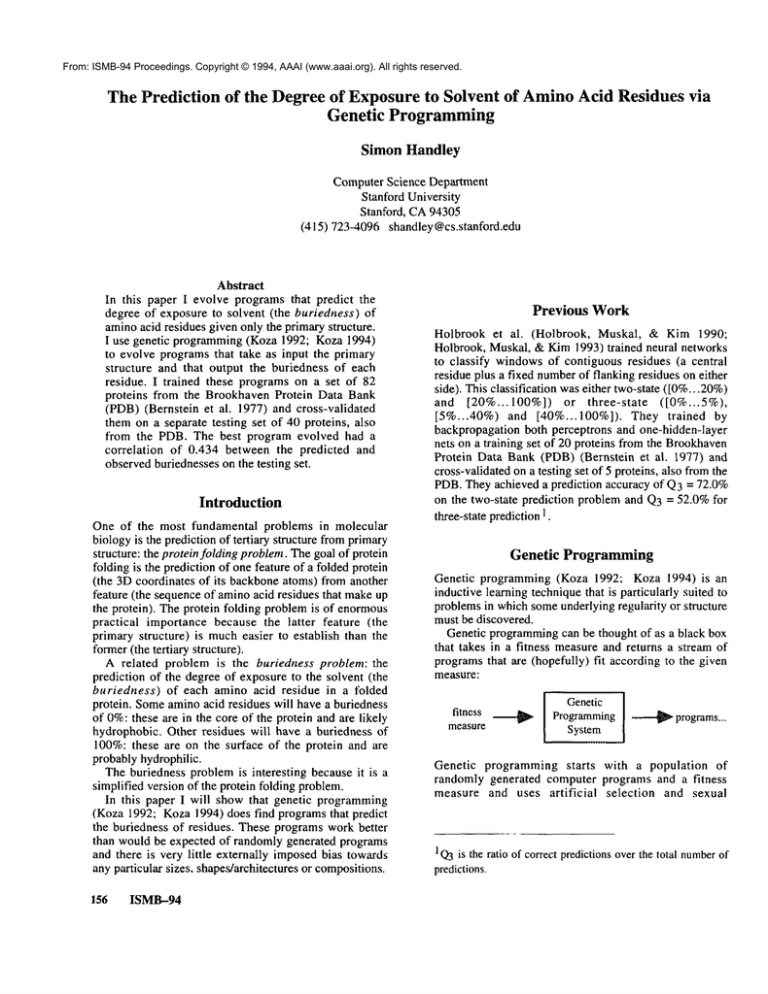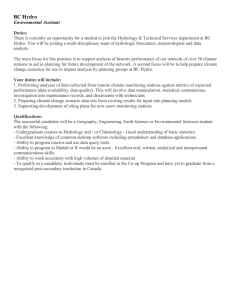
From: ISMB-94 Proceedings. Copyright © 1994, AAAI (www.aaai.org). All rights reserved.
The Prediction
of the Degree of Exposure to Solvent of Amino Acid Residues via
Genetic Programming
Simon Handley
Computer Science Department
Stanford University
Stanford, CA94305
(415) 723-4096 shandley @cs.stanford.edu
Abstract
In this paper I evolve programs that predict the
degree of exposure to solvent (the buriedness) of
aminoacid residues given only the primary structure.
I use genetic programming(Koza 1992; Koza 1994)
to evolve programs that take as input the primary
structure and that output the buriedness of each
residue. I trained these programs on a set of 82
proteins from the Brookhaven Protein Data Bank
(PDB)(Bernstein et al. 1977) and cross-validated
them on a separate testing set of 40 proteins, also
from the PDB. The best program evolved had a
correlation of 0.434 between the predicted and
observedburiednesses on the testing set.
Introduction
One of the most fundamental problems in molecular
biology is the prediction of tertiary structure from primary
structure: the protein folding problem.The goal of protein
folding is the prediction of one feature of a folded protein
(the 3D coordinates of its backboneatoms) from another
feature (the sequence of aminoacid residues that makeup
the protein). The protein folding problem is of enormous
practical importance because the latter feature (the
primary structure) is mucheasier to establish than the
former(the tertiary structure).
A related problem is the buriedness problem: the
prediction of the degree of exposure to the solvent (the
buriedness) of each amino acid residue in a folded
protein. Someaminoacid residues will have a buriedness
of 0%:these are in the core of the protein and are likely
hydrophobic. Other residues will have a buriedness of
100%:these are on the surface of the protein and are
probably hydrophilic.
The buriedness problem is interesting because it is a
simplified version of the protein folding problem.
In this paper I will show that genetic programming
(Koza 1992; Koza 1994) does find programs that predict
the buriedness of residues. These programs work better
than would be expected of randomly generated programs
and there is very little externally imposedbias towards
any particular sizes, shapes/architectures or compositions.
156
ISMB-94
Previous Work
Holbrook et al. (Holbrook, Muskal, & Kim 1990;
Holbrook, Muskal, & Kim1993) trained neural networks
to classify windowsof contiguous residues (a central
residue plus a fixed numberof flanking residues on either
side). This classification was either two-state ([0%...20%)
and [20%...100%]) or three-state
([0%...5%),
[5%...40%) and [40%...100%]).
They trained
backpropagation both perceptrons and one-hidden-layer
nets on a training set of 20 proteins from the Brookhaven
Protein Data Bank (PDB) (Bernstein et al. 1977)
cross-validated on a testing set of 5 proteins, also fromthe
PDB.They achieved a prediction accuracy of Q3 = 72.0%
on the two-state prediction problem and Q3 = 52.0%for
three-state prediction1.
Genetic Programming
Genetic programming (Koza 1992; Koza 1994) is
inductive learning techniquethat is particularly suited to
problemsin whichsomeunderlying regularity or structure
must be discovered.
Genetic programmingcan be thought of as a black box
that takes in a fitness measure and returns a stream of
programsthat are (hopefully) fit according to the given
measure:
fitness
measure
Genetic
Programming -------~ programs...
System
I
Genetic programming starts with a population of
randomly generated computer programs and a fitness
measure and uses artificial
selection and sexual
1 Q3is the ratio of correct predictionsoverthe total number
of
predictions.
Table1. The Brookhavenidentifiers of the 122 proteins used in this paper.
1CSE_E,ICSE_I, IECO, 1FKF, IFNR, 1FXD, 1GCR,1GDI_R,IGPI_B, IGPB, 1HIP, IHOE, IHRH_B,IHSA_D,IHSA_E,IHYP,
IIFB, 1LPE, 1LZ1, 1MBD,IMSB_B,INN2, INXB, 1OVA_D,1PAZ, IPGX, IPHH, 1PRC_C,1PRC_M,IPRC_H, IR69, IRBP,
IRHD, 1RNB_A,1RNH, IROP_A, ISN3, ITFD, ITIE, 1TPK_C, IUBQ, IUTG, IWSY_A,1WSY_B.IYCC, 256B_B, 2AZA_B,
2CA2, 2CCY_B,2CDV, 2CPP, 2CSC, 2ER7_E, 2FCR, 2GN5, 2HAD.2HBG, 2HMZ_D,2LH7, 2LIV, 2LTN_D,2MCM,2OVO,
2PAB_B,2RHE, 2RSP_B,2SAR_B,2SDH_B,2SGA, 2SIC_I, 2SNS, 2SOD_Y,2STV, 2TRX_B,2TSi, 2TSC_B,2WRP_R,2YHX,
3ADK,3B5C, 3BCL, 3CHY,3CLA,3GAP_B,3GRS, 3IL8, 3PGK, 3RUB_S,3SDP_B,451C, 4BP2, 4CPV, 4ENL. 4FXN,4lIB,
4LZM,4MDH_B,
4PFK, 4PTP, 4SGB_I, 4XIA_B,5ABP, 5ACN,5CPA, 5HVP_B,5P21, 5PTI, 5RUB_B,5RXN,5TIM_B,6LDH,
6TMNE, 7RSA, 8ADH,8ATCC, 8ATCD, 8CATB, 8DFR, 9ICD, 9PAP, 9RNT, 9WGA_B.
reproduction to produceincreasingly fitter populations of
computer programs.
A run of genetic programming is usually a fixed
numberof generations of such evolution. A programis a
compositionof functions and terminals. For example, 1 is
a programthat consists of a single terminal; ( + 1 2 )
another program, it is a composition of two terminals (1
and 2) and a function (+).
The programs in each generation of a run of genetic
programmingare created either by copying them from the
previous generation (with probability proportional to their
fitness) or by crossing over two parental programs(also
chosen with probability proportional to their fitness) and
placing the two resulting child programs in the new
generation.
The crossover operation works as follows. Let the two
parental programsbe
Choosing The Class of ProgramsTo Be
Evolved
problem and the function set contains the types of
computationyou expect to have to do to those inputs.
For this problem,the minimum
sufficient terminal set is
the amino acid residue at each position in the primary
structure (Anfinsen 1973). In addition, the programshave
access to the hydrophilicity (Kidera et al. 1985) of each
residue, the bulk (volume) of each residue and some
randomfloating point constants.
The function set contains two types of functions. First
there are functions that do simple computations: {*, ,*,%,if<= }where (if<= a b c d) =cifa<b;d
otherwise; and where (% a b) = a/b if b g: 0; 1
otherwise.
The remaining functions in the function set allow the
programs to look at multiple residues. Although the
buriedness problem as stated above is a mappingfrom a
list of aminoacid residues to a list of buriednesses, it is
easier to recast the problem as a mappingfrom a single
aminoacid residue to a single buriedness. A solution to
this simpler problem can then be applied to each amino
acid residue separately to determinethe buriedness of all
aminoacid residues in a protein. A programto solve this
simpler problem, however,must still look at the residues
surrounding the residue whoseburiedness it is computing.
The following "turtle" functions provide this contextual
information. The idea is that the programhas access to a
turtle (or read head) that walksto the left (towardsthe
temainal) or to the right (towards the C-terminal) along
the primary structure (or Turing tape). The programcan
look at the current residue (re s returns a number
corresponding to the current residue2, hydro returns the
current residue’s hydrophilicity
(in the range [1.25...2.06] and bulk retums the volumeof the current
residue (in the range [-2.16...2.08]) 3), movethe turtle to
the left by various amounts( ( left-1 ), ( left-2 )
(left-3)),
move the turtle
right ((right-l),
(right-2)
and (right-3))
and rubber-band
turtle back to someinitial position ((home)).
Finally, I scale the output of each programto be in the
range 0%to 100%.That is, to predict the buriedness of a
protein with a given program,the programis first run on
The most important input to a genetic programming
system is the class of programsto be evolved. This means
choosing a function set and a terminal set from whichthe
programs will be made up. For example, the programs in
the "Genetic Programming"section above are drawn from
a functionset of { +, * } anda terminalset of { 1, 2 ..... 8 }.
The terminal set can be thought of as the inputs to the
2Thereare 23 "residues": "don’t know"(X), "Dor E" (B), "N
Q" (Z) plus the 20 naturally occurring residues. These
residuesare randomly
assignedthe numbers
0... 22.
3Thehydrophilicity and bulk metrics used are fromcolumns1
and2 of Kideraet al.’s TableIII (Kideraet al. 1985).
(+ (* 1 2) (* 3 4)),and
(+ (+ 5 (+ 6 7))
The crossover operator randomly chooses an internal
point in each program. Twosuch choices are highlighted
here:
(+ (* 1 2) (* 3 4)),and
(+ (+ (+6 7))8).
The crossover operator then swaps these two fragments( * 3 4 ) and ( + 6 7 ) --to producethe child programs:
(+ (* 1 2) (+ 6 7)),and
(+ (+ 5 (* 3 4))
Although
theaboveblackboxhasonlyoneinput--the
fitness
measure--there
areactually
fourmaininputs
toa
genetic programmingsystem: the fitness measure, the
class of programs, the population size and the maximum
numberof generations to be evolved.
Handley
157
each amino acid residue in the primary structure. This
results in a list of floating point numbers,one per residue.
I then scale these numbersso that the largest is 100.0 and
the smallest is 0.0. I then interpret each numberas the
predicted percentage buriedness of the corresponding
residue.
Here’s an example:
{ home,left-l,left-2,left-3,
right-l,right-2,right-3}.
Choosing The Remaining Inputs
The fitness measureshould reward programsthat perform
well at the desired task. Here I want to evolve programs
that are goodpredictors of buriedness. So the fitness of a
program is defined as the similarity
between its
predictions and the knownburiednesses (as computedby
Kabsch and Sander (Kabsch & Sander 1983) from the 3-D
coordinates in the PDB). I quantified similarity as the
correlation coefficient betweenthe two real-valued curves
(predicted and observed buriednesses as a function of
residue number).
Twoquestions remain: First, howmanyindividuals will
there be in each population? This is the population size,
M. Second, for how many generations should the
evolution
run? This is the maximum number of
generations, G.
Thepopulation size should be large enoughthat there is
enoughgenetic diversity to solve the problem. It should
be small enoughthat useful results can be obtained in a
reasonable amount of time on whatever computers are
available. For the results shownhere I used a population
size, M,of 4,000.
Similarly, the maximum
numberof generations should
be chosen to optimize computertime. I chose G = 76 (1
initial random population + 75 subsequent evolved
populations) for the runs reported here.
(if<: hydro (left-i hydro)
(* 2 (+ (home (left-i bulk))
(right-I bulk)))
(% bulk (right-i bulk)))
This program does one of two things: if the current
residue is less hydrophilic than the one to its left then it
returns twice the sumof the bulkinesses of the residues
immediately to the left and to the right; otherwise it
returns the ratio of the bulkiness of the current residue and
the residue to its immediate right. To predict the
buriedness of all the residues in a protein, this program
will be run separately on each residue in the primary
structure.
In summary,the terminal set contains functions that
return information about the residue that the turtle is
looking at plus somerandomconstants,
T = { res,hydro,bulk,~ }
where~Ris replaced in the initial generation of randomlycreated computer programs by random floating point
constantsin the range [- 10.0,+ 10.0].
The function set contains two types of functions: those
that do simple computationsand those that movethe turtle
around:
F= { +, -, *, %, if<= }<)
0.44
°0.42
0.40.o
0.38-
tI
B::I ~ ~ii~g~S
.................
ca
0.360.34"
0.32"
0.30 ....
0
I
10
I
20
’ ---
I
30
I
40
I
50
60
Generation
Figure 1. Correlation between the observed and predicted buriedness for best (on the training set) individual of each
generation, tested on both the training set and the testing set. Averagedover the 15 runs. Note that the values for generation
58 are based on only one run.
158 ISMB--94
The Data
I used 122 canonical proteins from the PDBthat Tod
Klingler (personal communication)selected for me. These
122 proteins are canonical in the sense that there is
minimal sequence identity and evolutionary homology
between them. Table 1 shows the Brookhavenidentifiers
of these proteins.
To cross-validate the predictive powerof the programs
that evolved, I divided the 122 proteins into a training set
and a testing set. The 122proteins were partitioned so that
one third of the proteins were in the testing set and the
remaining two thirds made up the training set. The
possible testing sets were: proteins 0--39, proteins 40-79,
and proteins 80-119; one of these three testing sets was
chosen randomlyfor each run.
Results
I did 15 runs with M= 4,000 and G = 76. An average of
33.8 generations were evolved for each run. The
evolutionary process was driven by the proteins in the
training set (two-thirds of the 122 proteins). That is,
defined fitness as the similarity between a program’s
predictions and the observedreality for the proteins in the
training set. Separately, I reran the best individual of each
generation of each run on the testing set (the remaining
one-third of the 122 proteins). The difference betweenthe
predictive performance on the training and testing sets
gives a measure of howmucheach programis overfitting
the training data; that is, the degree to whicha program
does better on the training set than the testing set showsto
what degree the programis looking at irrelevant aspects
of the problem (i.e., aspects that aren’t shared by the
proteins in the testing set).
Figure 1 plots the correlation betweenthe observedand
predicted buriedness curves on both the training and
testing sets, averaged over the 15 runs. The best
performance on the testing set of all the generation 0
individuals (i.e., the best of the best of generation0s, not
the averageof the best of generation 0s) is C = 0.359. This
indicates the ability of random search to solve this
problem.
Table 2 shows two best-of-generation ("best" here
meaningbest on the training set) individuals that had high
predictive poweron the testing set.
Conclusions
I have shownthat it is possible to evolve programsthat
predict the degree to which an amino acid residue is
exposed to the solvent. The best programproduced by the
evolutionary process had a correlation of 0.434 between
the observedand predicted buriednesses on the testing set
of 40 proteins.
Acknowledgments
I’d like to thank: John Koza and James Rice for their
support and genetic programmingexpertise; Tod Klingler
for selecting the proteins; and the anonymousreviewers
for their comments.
References
Anfinsen, C. B. Principles that govern the folding of
protein chains. Science 81 (1973): 223-30.
Bernstein, F. C.; Koetzle, T. F.; Williams, G. J. B.;
Meyer,J., E. J.; Brice, M. D.; Rodgers,J. R.; Kennard,O.;
Shimamouchi,T.; and Tasumi, M. The protein data bank:
A computer based archival file for macromolecular
structures. Journal of Molecular Biology 112 (1977):
535--42.
Holbrook, S. R.; Muskal, S. M.; and Kim, S.-H.
Predicting surface exposure of amino acids from protein
sequence. Protein Engineering 3 (8 1990): 659-65.
Holbrook, S. R.; Muskal, S. M.; and Kim, S.-H.
"Predicting protein structural features with artificial
neural networks." In Artificial Intelligence and Molecular
Biology, ed. Hunter, L. 161-94. AAAIPress, 1993.
Kabsch, W. and Sander, C. Dictionary of protein
secondary structure: Pattern recognition of hydrogenbonded and geometrical features. Biopolymers22 (1983):
2577-637.
Kidera, A.; Konishi, Y.; Oka, M.; Ooi, T.; and Scheraga,
H. A. Statistical analysis of the physical properties of the
20 naturally occurring amino acids. Journal of Protein
Chemistry 4 (1985): 23-55.
Koza, J. R. Genetic Programming:On the Programming
of Computersby Meansof Natural Selection. Cambridge,
MA:MITPress, 1992.
Koza, J. R. Genetic Programming Ii: Automatic
Discover5, of Reusable Programs. Cambridge, MA:MIT
Press, 1994.
Handley
159
Numberof points: 141. Occurred at generation: 51. Performance on training set: C = 0.429, two-state Q3 = 68.5%, threestate Q3 = 66.9%. Performance on testing set: C = 0.434, two-state Q3 = 70.0%, three-state 0_3 = 68.4%.
(if<= (* hydro -6.02425)
(right-2 (left-2 (* hydro -4.27684)))
(if<=
hydro (+ (+ (* hydro -8.22096)
6.5959) hydro)) (if<= hydro (* hydro
(left-i (home res)) (if<= hydro (if<= hydro (% hydro -3.20838) (left-I
hydro) (if<= hydro (% (+ (- bulk hydro) 6.5959) (* res (* 6.5959 res)))
(home hydro)) -7.89316))
(if<= hydro -8.22096
(if<= hydro (* hydro -6.02425)
(left-2 hydro) (left-i 7.08283)) -7.89316)) (if<= hydro (- (- bulk hydro)
(if<= (home res) (if<= res bulk hydro (home (if<= hydro (* hydro -3.20838)
7..08283) hydro))) (% hydro (+ (+ bulk bulk) hydro)) (- (+ bulk bulk)
(+ hydro -1.88183))))
(if<= hydro (* hydro -3.20838) (home (- (+ (+
bulk) hydro)) (if<= hydro (* hydro -3.20838) (if<= hydro (* hydro -3.20838)
(- (- bulk hydro) hydro)) (home hydro)) (home
if H0 ~0.77 then
if ifH_1H_~ H_
2 then
2 < B_
2 - H_2 + 6.6 then
6.6R~
2
-3.21
else
H-2
endif
else
-7.89
endif
else
-7.89
endif
Numberof points: 79. Occurred at generation: 37. Performance on training set: C = 0.428, two-state Q3 = 69.6%, threestate Q3 = 68.0%. Performance on testing set: C = 0.432, two-state Q3 = 71.1%, three-state Q3 = 69.5%.
(if<= bulk (- (% (+ -1.74019 hydro) hydro) (+ -1.74019 hydro)) (+ (* (home
0.507344)) (% bulk 5.08997)) (- (left-2 8.6028) (home (home (right-3
(if<= (left-i (+ -1.74019 hydro)) (right-2 res) (if<= (left-i hydro)
hydro) (+ (left-2 8.6028) (- (- (left-2 8.6028) (home (right-3
hydro)))
(home (right-3 hydro))))) (if<= bulk (- res 0.507344) (home -4.11196)
(if<= res (home (- res 0.507344)) (home (right-3 hydro)) (+ -1.74019 hydro)))))
bulk 5.08997)))
if B0 <_(Ho-1.74)/Ho-Ho-I.74
5.09 R0 -0"51 t. 8.6_ HI
then
else
if H_1 -1.74<R+1 then
if H0 < 0 then
17.2 - H_1 - H+2
else
if B0 _< RO-0.51 then-4.11 else -3.12-H 0 endif
eadif
else
B0/5.1
endif
eadif
Table 2. Twoof the five best (on the testing set) best-(on the training set)of-generation individuals. (The other three
minor variations of these two.) The table shows both the actual function that evolved and a simplified version of the
function. The simplifications were done by hand and assumed that turtle movements were always successful (this means
that (left-2 (right-2 x) ) simplifies to x which is not true if the turtle is within 1 residue of the N-terminah
attempt to moveleft two residues would fail but the attempt to moveright two residues would succeed. (Notation: H8 is the
hydrophilicity of the residue 8 residues away from the current residue, B8 and R,5 are defined similarly.)
160
ISMB-94


